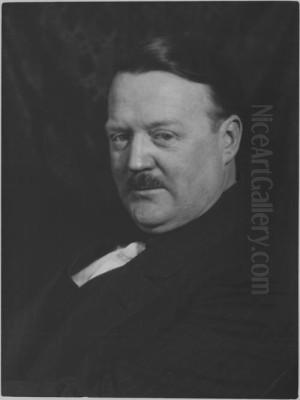
Francis Hans Johnston stands as a significant yet distinct figure in the annals of Canadian art history. Born in Toronto in 1888 and passing away in the same city in 1949, Johnston's life spanned a transformative period for Canadian culture and identity. Primarily celebrated as a landscape painter, he was an original member of the iconic Group of Seven, though his path eventually diverged from the collective. His prolific output and mastery in capturing the unique qualities of Canadian light and atmosphere earned him widespread recognition during his lifetime and secured his place as a foundational artist in the country's visual heritage.
Early Life and Artistic Formation
Johnston's artistic journey began in his native Toronto. Showing promise early on, he pursued formal training at the Central Ontario School of Art and Design (later the Ontario College of Art, now OCAD University). There, he studied under influential Canadian artists such as Gustav Hahn, George Agnew Reid, and William Cruikshank, absorbing the academic traditions prevalent at the time. This foundational education provided him with the technical skills necessary for his future explorations in landscape painting and commercial design.
Seeking broader horizons, Johnston traveled to the United States around 1912 to study at the prestigious Pennsylvania Academy of the Fine Arts (PAFA) in Philadelphia. PAFA was a vibrant centre for American art, exposing students to various currents, including American Impressionism and Realism. While specific instructors' direct influence is debated, the environment undoubtedly broadened Johnston's artistic perspectives, potentially exposing him to the works of figures associated with the Academy like Thomas Eakins or William Merritt Chase, known for their distinct approaches to light and form. This period also saw him begin working professionally to support his studies.
The Grip Ltd. Crucible
Returning to Toronto, Johnston entered the world of commercial art, a common path for many aspiring fine artists of his generation seeking financial stability. Around 1911, before his PAFA studies, and again upon his return, he joined Grip Ltd., a prominent graphic design firm. This company inadvertently became a crucial incubator for Canadian modernism. It was here that Johnston worked alongside several artists who would later form the core of the Group of Seven.

At Grip, Johnston honed his design skills alongside colleagues like J.E.H. MacDonald, Arthur Lismer, Frederick Varley, and Franklin Carmichael. The legendary Tom Thomson, though perhaps not a direct colleague for an extended period, was also closely associated with this circle through his own commercial work and friendships. Lawren Harris, a key visionary for the Group, was also part of this milieu, connecting with the Grip artists. The demanding nature of commercial illustration required precision, strong composition, and an ability to convey mood efficiently, skills that arguably informed Johnston's later easel painting.
The environment at Grip fostered camaraderie and shared artistic ambition. Discussions about creating a distinctly Canadian art, moving beyond European conventions to capture the rugged spirit of the northern landscape, were common. While fulfilling commercial assignments, these artists sketched and painted in their spare time, often venturing into the Ontario wilderness together, laying the groundwork for a national art movement. Johnston was an active participant in these early explorations and discussions.
Wartime Contributions and Algoma Expeditions
The outbreak of World War I temporarily shifted the focus for many artists. In 1918, Johnston received a commission from the Canadian War Memorials Fund. His task was to document the training activities of the Royal Flying Corps pilots at various airfields in Ontario. This work required him to capture scenes of aviation and military life, adding another dimension to his artistic experience beyond pure landscape or design. His paintings from this period offer valuable historical records and demonstrate his versatility.
Perhaps more pivotal for his landscape art were the sketching trips to the Algoma region of Northern Ontario, facilitated by his friend and patron, Lawren Harris. In the autumn of 1918, Johnston joined Harris and J.E.H. MacDonald on the first famous "boxcar trip" along the Algoma Central Railway. Equipped with a specially outfitted railway car, they could access remote wilderness areas, sketching and painting directly from nature. A.Y. Jackson, another future Group member and war artist, also participated in subsequent Algoma excursions.
The Algoma landscape, with its dramatic hills, vibrant autumn colours, deep forests, and rushing rivers, profoundly impacted Johnston. The raw beauty and untamed character of the region provided rich subject matter that resonated with the burgeoning desire to depict a uniquely Canadian identity. The sketches and studies made during these trips formed the basis for many of Johnston's most celebrated canvases, capturing the specific light and atmosphere of this northern wilderness.
The Group of Seven: Formation and Departure
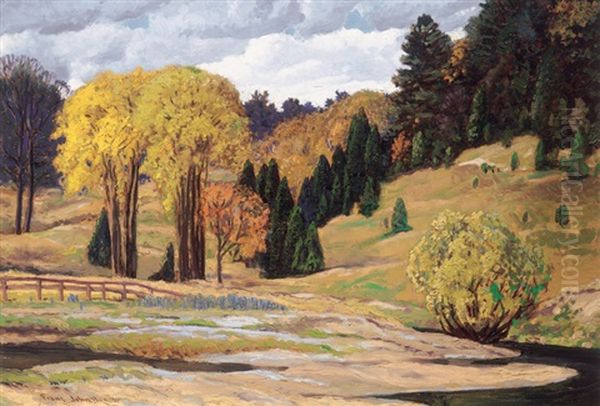
The shared experiences and artistic vision cultivated during the Grip Ltd. days and the wilderness sketching trips culminated in the formal establishment of the Group of Seven in 1920. Francis Johnston was among the founding members, alongside Lawren Harris, J.E.H. MacDonald, Arthur Lismer, Frederick Varley, Franklin Carmichael, and A.Y. Jackson. Their inaugural exhibition at the Art Gallery of Toronto (now the Art Gallery of Ontario) in May 1920 was a landmark event, boldly presenting their vision of the Canadian landscape.
Johnston contributed significantly to the early Group exhibitions, showing works alongside his peers in 1920, 1921, and 1922. His paintings from this period often reflected the shared enthusiasm for the northern landscape, particularly Algoma subjects. However, his artistic temperament and career goals began to diverge from the collective's trajectory. While the Group championed a progressively stylized and modernist interpretation of the landscape, Johnston retained a stronger connection to realism and traditional techniques, focusing intently on capturing the subtleties of light and atmosphere.
By 1921, Johnston had formally resigned his position as Principal of the Winnipeg School of Art (a role he took up shortly after the Group's formation) and by 1924, he had officially withdrawn from the Group of Seven. The reasons cited often include his desire for greater artistic independence, a preference for a more detailed and less stylized approach than some of his colleagues, potential personality differences, and the practical need to pursue a more commercially viable solo career to support his family. His departure was amicable, and he maintained relationships with the other members, but he chose to forge his own path. Around 1926-27, he also began using the name "Franz" and later settled on "Francis Hans Johnston," perhaps to further distinguish himself professionally.
Developing a Distinctive Style
Freed from the stylistic expectations of the Group, Johnston cultivated a highly personal and recognizable style. While associated with the Group's initial push, his mature work often presents a different sensibility. He became renowned as a "painter of light," demonstrating an exceptional ability to render the effects of sunlight and shadow on landscapes, particularly snow and water. His paintings often possess a luminous quality, capturing specific times of day and atmospheric conditions with remarkable fidelity.
Johnston's technique balanced decorative qualities with naturalistic observation. He employed rich colour harmonies and sometimes flattened perspectives reminiscent of decorative design, likely influenced by his commercial background. However, this was usually combined with meticulous attention to detail and a convincing sense of depth and space. He was particularly adept at depicting the textures of snow, the reflections in calm water, and the intricate patterns of forest interiors.
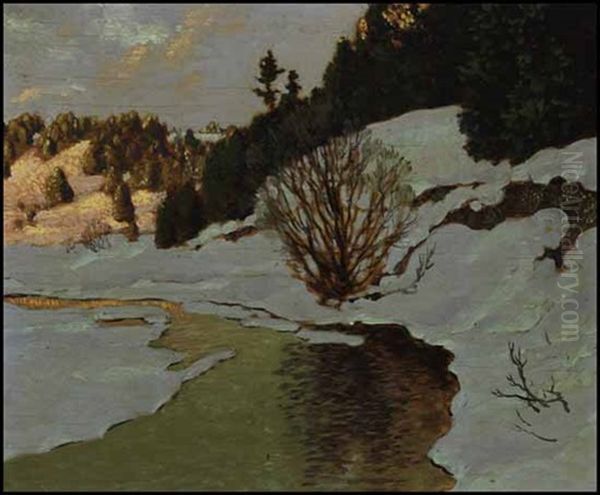
Compared to the bold, often stark, modernism of Lawren Harris or the rugged textures of J.E.H. MacDonald, Johnston's work often feels more lyrical and romantic. He frequently returned to themes of serenity and the quiet beauty of nature, rather than solely focusing on its raw power. His handling of paint could range from smooth, detailed passages to more broken brushwork reminiscent of Impressionism, adapted to suit the subject and desired effect. He was less interested in symbolic representation than some Group members, focusing instead on the direct visual experience of the landscape.
Key Themes and Representative Works
Johnston's vast output explored several recurring themes, primarily centred on the Canadian landscape across different seasons and regions. His Algoma paintings remain iconic examples of his early association with the Group of Seven. Fire Swept, Algoma (c. 1920) is a powerful depiction of the aftermath of a forest fire, showcasing dramatic light and a landscape scarred but regenerating, a theme resonant with post-war Canada and the Group's interest in nature's cycles.
His mastery of light on water is exemplified in works like Opal Pool, where shimmering reflections and the subtle play of light filtering through trees create a scene of tranquil beauty. He captured the unique luminescence of forest streams and lakes with exceptional skill, often focusing on the interplay between water, rocks, and foliage. These works highlight his sensitivity to delicate tonal variations and his ability to evoke a sense of place.
Winter landscapes were a particular forte for Johnston. He seemed fascinated by the transformative effect of snow and the unique quality of light during Canadian winters. Paintings such as Serenity, Lake of the Woods (1922) or Golden Afterglow capture the low winter sun casting long shadows and warm hues across snow-covered forests and frozen lakes. He expertly rendered the different textures of snow – powdery, melting, or crusted – and the way light reflects and refracts off its surface, creating scenes of both starkness and subtle beauty.
Beyond the dramatic wilderness, Johnston also painted more pastoral scenes, such as views around the Don Valley in Toronto (Mills River, Don, 1928) or the gentler landscapes of Southern Ontario (York Mills Valley). These works demonstrate his versatility and his appreciation for cultivated or less remote natural settings. Throughout his career, his focus remained steadfastly on capturing the essence of the Canadian environment through careful observation and masterful technique. While primarily a realist, some later works show experimentation with broader brushwork and more decorative compositions.
A Prolific and Independent Career
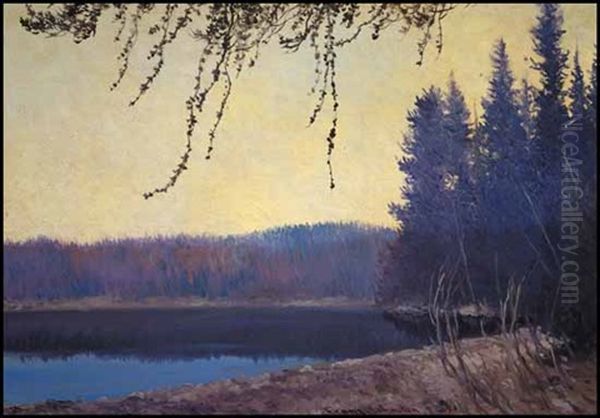
After leaving the Group of Seven, Johnston embarked on a highly successful independent career. His move to Winnipeg in 1921 to become Principal of the Winnipeg School of Art and Gallery marked a significant step into arts education. He brought energy and his experience to the role, influencing a generation of prairie artists. However, he returned to Toronto after a few years, drawn back to the artistic centre and landscape subjects of Ontario.
Back in Toronto, Johnston taught at the Ontario College of Art, the very institution where he had studied. His practical experience and established reputation made him a valuable instructor. He eventually established his own summer art school, the Johnston Academy of Fine Art, located on the picturesque shores of Georgian Bay. This allowed him to combine his passion for teaching with his love for painting the Canadian Shield landscape, offering students direct immersion in the environment.
Johnston became one of Canada's most commercially successful artists during the 1920s and 1930s. He held numerous solo exhibitions across the country, and his accessible, beautifully rendered landscapes found favour with a wide public audience and collectors. His ability to capture the familiar beauty of the Canadian scene, combined with his technical brilliance, ensured steady sales and critical acclaim, even as artistic trends shifted towards greater abstraction elsewhere. His prolific nature meant he produced thousands of works, ranging from small oil sketches to large exhibition canvases.
Artistic Influences and Connections
Johnston's artistic development was shaped by a network of influences and relationships. His initial training under George Agnew Reid and William Cruikshank grounded him in academic principles. His time at Grip Ltd. forged lasting connections with J.E.H. MacDonald, Arthur Lismer, Frederick Varley, Franklin Carmichael, and brought him into the orbit of Tom Thomson and Lawren Harris. These interactions were crucial in shaping the early ideals of the Group of Seven.
While a member of the Group, he was undoubtedly influenced by the collective's focus on Canadian subject matter and plein-air sketching, particularly through the Algoma trips with Harris and MacDonald. However, his style also shows affinities with other contemporaries outside the core Group. His emphasis on light and atmosphere might echo aspects of Canadian Impressionists like Maurice Cullen or Marc-Aurèle de Foy Suzor-Coté, or landscapists like J.W. Beatty, who also explored Northern Ontario themes before the Group.
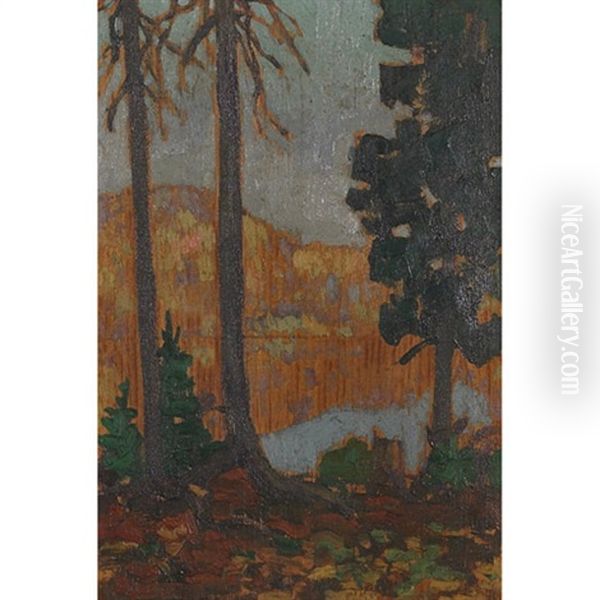
His studies in the US at PAFA exposed him to American art currents. While direct links are speculative, the atmospheric concerns of American Tonalists or the light-filled canvases of American Impressionists like Childe Hassam might have resonated with his own inclinations. Ultimately, Johnston synthesized these various influences into a style uniquely his own, less radical than some of his Group peers but deeply attuned to the nuances of the Canadian landscape. His work provided a bridge between traditional landscape painting and the burgeoning modernist movement in Canada.
Legacy and Recognition
Francis Hans Johnston's legacy is multifaceted. As an original member of the Group of Seven, he played a role in one of the most pivotal moments in Canadian art history, helping to forge a national artistic identity centred on the landscape. Although he pursued an independent path, his early contributions and association with the Group remain significant. His departure highlights the diversity of artistic vision even within that influential circle.
His primary legacy lies in his extensive body of work. As a master painter of light and atmosphere, particularly renowned for his snow scenes and water reflections, he captured the Canadian landscape with a sensitivity and technical skill that continues to resonate. His paintings offer evocative glimpses into the wilderness of Algoma, the shores of Georgian Bay, and the familiar scenes of Southern Ontario. His prolific output ensured his work reached a wide audience and became deeply ingrained in the Canadian visual consciousness.
Johnston was also an important educator, influencing students first in Winnipeg and later at the Ontario College of Art and his own summer school. He passed on his technical knowledge and his passion for landscape painting to younger generations. Today, his works are held in major public collections across Canada, including the National Gallery of Canada, the Art Gallery of Ontario, and the McMichael Canadian Art Collection, ensuring his contribution is preserved and studied. He remains recognized as a key figure in the development of Canadian landscape painting, admired for his technical mastery and his ability to convey the subtle beauties of his native land.
Conclusion
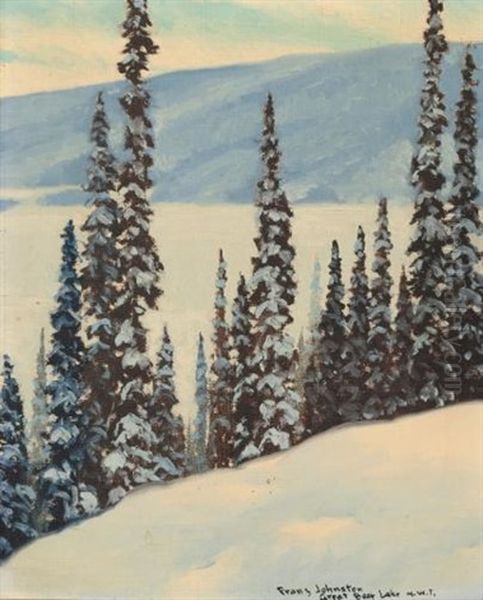
Francis Hans Johnston occupies a unique and enduring place in Canadian art. An original member of the Group of Seven, he shared their initial passion for depicting the Canadian wilderness but ultimately followed his own artistic compass, developing a distinctive style focused on the masterful rendering of light and atmosphere. His prolific career, marked by both critical acclaim and popular success, produced an extensive body of work celebrating the diverse landscapes of Canada, particularly his luminous snow scenes and tranquil water studies. Both through his art and his role as an educator, Johnston made a lasting contribution to Canada's cultural heritage, leaving behind a legacy as one of the nation's most skilled and beloved landscape painters.